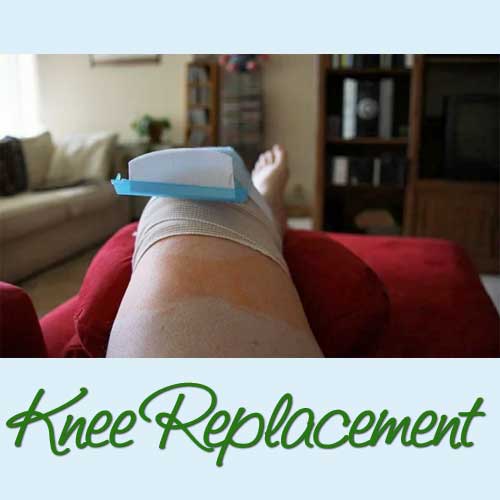As we get older cartilage in our knees begins to wear down. Sometimes this happens because of age related arthritis (Osteoarthritis) or because of an autoimmune disease like Rheumatoid arthritis or because of a knee injury. It does not matter how, it only matters that there is a way to help with the pain that comes with it. Knee Replacement Surgery is sometimes an option.
In 1912 a physician from Denmark, Dr. Severin Nordentof, used an endoscope to look inside a knee. 1968 the first knee replacement surgery was completed, however it was not reliable. In 1974 a modern knee replacement was successfully achieved by John N. Insall, MD, Chitranjan Ranawat, MD, and Allan E. Inglis, MD, along with biomechanical engineer Peter Walker, PhD who had designed the replacement to work like our healthy knees work. Many athletes have had knee replacement type surgeries due to injuries or because of arthritis and age. 600,000 knee replacement surgeries are performed every year in the United States. This is the most common surgery that is done.
Knee replacement also known as Arthoplasty is where the surgeon removes the damaged knee and replaces it with an artificial one made of metal and plastic. The new knee gets attached to the thigh bone, shin, and kneecap with acrylic cement. There are four reasons you can consider getting a knee replacement:
- Age-related Osteoarthritis: This is the most common reason for getting surgery. It happens when the cartilage, the cushion between the knees and bone joints breakdown and your knees are bone on bone.
- Rheumatoid Arthritis: The immune system attacks and destroys the lining of the knee.
- Deformities: Like bow legs. Surgery repositions the knee.
- Knee Injuries: Broken bones and torn ligaments around the knee. Many athletes have this issue.
Here are the types of surgeries:
- Total Knee Replacement: This is the most common. The surgeon replaces the surfaces of the thigh bones and shin bones that connects to the knees.
- Partial Knee: This is done only if one side of your knee is damaged. You have to have strong ligaments and the rest of the knee is strong.
- Pateollofemoral Replacement: This is done just under the knee cap and the groove it sits in.
- Complex Revision Knee Replacement: Only done if you have had 2 or more replacement surgeries.
- Cartilage Restoration: Done when the knee has an isolated area of injury. They use grafts or cells of cartilage are used to grow new cartilage.
When you get a knee replacement it usually lasts 20 years. There are some risks involved, most of them are risks you have anytime you have surgery.
Risks of Knee Replacement Surgery:
- Infection
- Blood clots in the legs
- Blood clots in lungs
- Heart attack
- Stroke
- Nerve damage
After surgery you have to meet some milestones before being released from the hospital. You are usually in the hospital for 3 days. The first day they will get you up and start the process of moving your body. They will give you a walker to aid you in standing and getting around.
Here are the milestones you must reach to be released from the hospital after Knee Replacement Surgery:
- Standing
- Getting around with a walking device
- Be able to flex and extend your knees
Long term it will generally take 3 to 6 months to heal effectively. You will be in physical therapy so you can walk and move your knee safely and correctly. It is important to keep moving and commit to specific exercises even after physical therapy.
The Wellness Works NW Team look forward to helping you recover and learn to move your new knees so they stay strong and healthy as you age. Karen G Clemenson is a great resource for corrective exercises that will aid in your healing and she enjoys working with physical trainers and medical professionals. Let us know how we can help you achieve your wellness goals.
Here are some links I would like to share with you:
- 10 knee surgeries that impact history by Laura Dyrda for Becker’s Spine Review
- How to Prepare for Recovery After Knee Replacement Surgery by Kristeen Cherney and medically reviewed by Gregory Minnis, DPT for Healthline
- Knee replacement by Mayo Clinic Staff
- What’s Knee Replacement Surgery? by WebMD Staff
- Image Credit: How long does it take to recover from total knee replacement surgery? by Bone Smart Staff: Photo by Tim Evanson
Related Articles:
To look for a particular topic please see our Healthy Living Blogs page. If you don’t find what you are looking for please click on the button below to fill out a request form and someone from Our Team will be glad to research it for you for FREE!
 Jamie Holloway is a co-owner of Wellness Works NW and she is also our Research Manager and writes our Chasing Wellness with Jamie Holloway and Dear Jamie columns. Jamie is also an Independent Wellness Advocate at dōTERRA. She lives in the Portland, Oregon area. Since October 2011 she has been sharing her Journey Toward Health and Wellness with Vasculitis through her blog at JamieChasesButterflies.com. We hope you are as inspired as we are with the raw candor Jamie uses in her writing. If you would like to help support Jamie’s writing efforts please Donate now.
Jamie Holloway is a co-owner of Wellness Works NW and she is also our Research Manager and writes our Chasing Wellness with Jamie Holloway and Dear Jamie columns. Jamie is also an Independent Wellness Advocate at dōTERRA. She lives in the Portland, Oregon area. Since October 2011 she has been sharing her Journey Toward Health and Wellness with Vasculitis through her blog at JamieChasesButterflies.com. We hope you are as inspired as we are with the raw candor Jamie uses in her writing. If you would like to help support Jamie’s writing efforts please Donate now.













